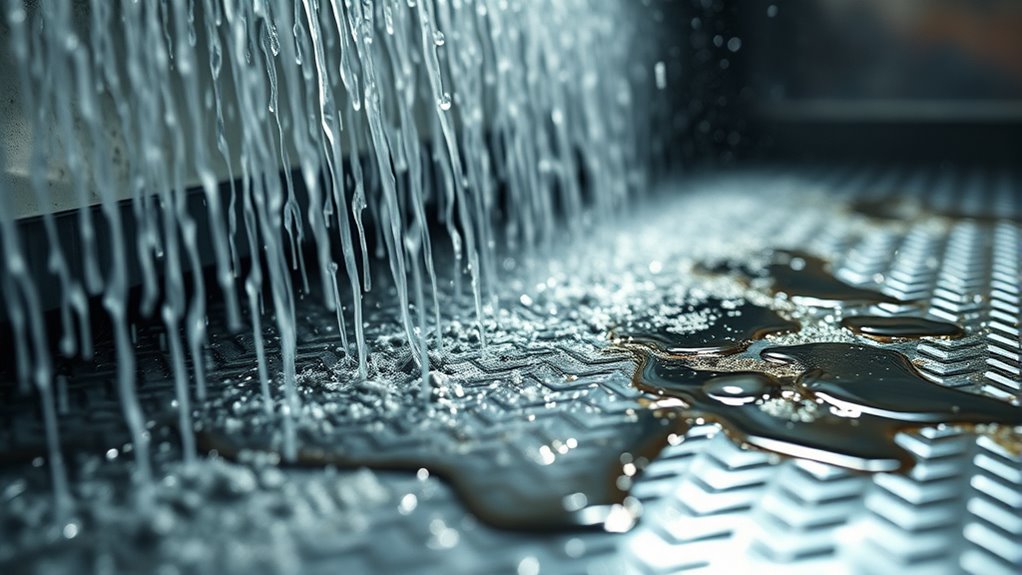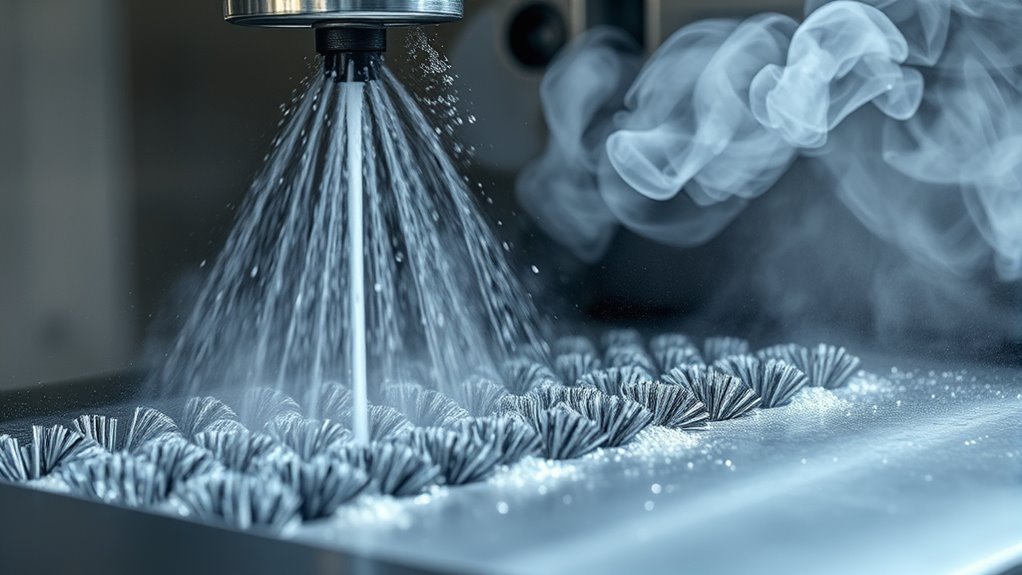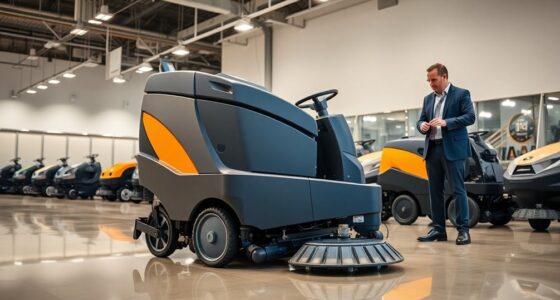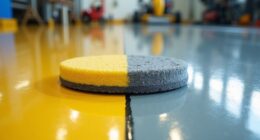Degreasing scrubber technologies for oil and grease removal combine biological and chemical methods to target stubborn, heavy contaminants effectively. You can use biological systems with microorganisms to naturally break down oils and greases, reducing chemical use and environmental impact. Chemical cleaning solutions quickly dissolve residues when needed, ensuring efficient removal. Modern systems integrate both approaches for ideal performance, compliance, and sustainability. If you keep exploring, you’ll discover how these advanced solutions can enhance your operations even further.
Key Takeaways
- Degreasing scrubbers utilize biological treatments with microorganisms to break down water-soluble oils and greases efficiently.
- Chemical cleaning solutions are used in conjunction with biological methods for rapid removal of stubborn residues.
- Modern systems integrate biological and chemical processes for enhanced oil and grease removal and reduced environmental impact.
- Biological scrubbers decrease chemical usage and waste, promoting eco-friendly and sustainable degreasing operations.
- Selection of scrubber technology depends on emission types, contaminant characteristics, and regulatory requirements.

Degreasing scrubber technologies play a crucial role in removing stubborn oils, greases, and other contaminants from industrial emissions. When tackling heavy-duty grease and oil buildup, you need effective solutions that can handle complex residues while maintaining safety and environmental standards. These technologies often incorporate biological treatment methods, which utilize naturally occurring microorganisms to break down organic contaminants, making them an eco-friendly alternative to traditional cleaning approaches. Biological treatment is especially useful when dealing with water-soluble oils and greases, as the microbes metabolize these substances, converting them into harmless byproducts. This process reduces the need for harsh chemicals and minimizes waste, supporting sustainable operations.
Biological treatment in degreasing scrubbers effectively breaks down oils and greases, supporting eco-friendly emission control.
In addition to biological treatment, chemical cleaning is a common component in degreasing scrubber systems. Chemical cleaning involves applying specially formulated solutions that dissolve or loosen oil and grease deposits, facilitating their removal from surfaces and emissions. This method is effective for rapid cleaning cycles and can be tailored to target particular types of contaminants. When used in conjunction with scrubbers, chemical cleaning enhances the overall efficiency of the system, ensuring that emissions are thoroughly treated before release. You should consider chemical cleaning if your operation involves heavy or stubborn residues that biological treatment alone might struggle to handle efficiently. Combining both approaches allows you to optimize cleaning performance while balancing environmental concerns and operational costs.
Modern degreasing scrubber systems often integrate biological treatment units with chemical cleaning stages, creating a versatile and effective pollution control process. The biological treatment stage typically precedes or follows chemical cleaning, depending on the specific application and contaminant type. This integration helps you achieve a more thorough removal of oils and greases, reducing the load on downstream environmental controls. Additionally, advancements in scrubber design have made these systems more automated and easier to maintain, giving you better control over treatment efficiency and operational costs. Moreover, understanding the health implications of working with various cleaning agents is crucial to ensuring a safe environment for your workforce.
Your choice of degreasing scrubber technology should be guided by the nature of your emissions, the types of oils and greases involved, and environmental regulations. Emphasizing biological treatment can reduce chemical usage and waste generation, aligning your operations with sustainability goals. Meanwhile, chemical cleaning offers quick, targeted removal for particularly challenging residues. Combining these methods allows you to develop a tailored solution that maximizes removal efficiency, minimizes environmental impact, and ensures compliance with regulatory standards. Ultimately, investing in advanced scrubber technologies supports cleaner operations, protects your workforce, and promotes long-term environmental responsibility.
Frequently Asked Questions
What Are the Environmental Impacts of Degreasing Scrubbers?
Degreasing scrubbers can impact the environment by reducing air pollution, as they control emissions of harmful vapors. However, they may also cause water contamination if waste residues or cleaning chemicals aren’t properly managed. You should guarantee proper disposal and containment of waste to minimize these risks. When used correctly, scrubbers help improve air quality while preventing potential water pollution, making them environmentally beneficial if maintained properly.
How Do Cost Efficiencies Vary Among Different Scrubber Technologies?
You’ll find that cost efficiencies among scrubber technologies vary considerably; for example, wet scrubbers often have a 20% higher initial investment but lower operational costs compared to dry systems. A detailed cost comparison reveals efficiency metrics that influence long-term savings. Ultimately, choosing the right technology depends on balancing upfront costs with ongoing operational expenses, ensuring you optimize both environmental compliance and budget management effectively.
Can Scrubbers Be Customized for Specific Industrial Applications?
Yes, you can customize scrubbers for specific industrial applications. Manufacturers offer a range of customization options, allowing you to tailor the application-specific design to meet your needs. You can select materials resistant to harsh substances, adjust size and capacity, and incorporate features like specialized filters or cleaning systems. This customization guarantees superior performance and efficiency, helping you address unique challenges in your industry effectively.
What Maintenance Is Required for Long-Term Operation?
Oh, sure, maintenance is a breeze, right? Keep to your maintenance schedules and check component durability regularly. Replace worn parts before they fail, and clean filters to prevent buildup. It’s almost like caring for a pet—neglect it, and it’ll bite back. Staying proactive guarantees your scrubber runs smoothly long-term, saving you headaches and costly repairs. So, stay vigilant, and your equipment will thank you with reliable performance.
Are There Regulatory Standards Influencing Scrubber Selection?
Yes, regulatory standards influence your choice of scrubbers. You need to guarantee compliance with emission standards set by authorities, which often specify the type and efficiency of degreasing scrubber technologies. By selecting a scrubber that meets these standards, you can avoid penalties and ensure environmentally responsible operations. Always stay updated on evolving regulations to choose the best technology that aligns with current compliance requirements and optimizes your degreasing process.
Conclusion
Just as Icarus sought to tame the sun’s fiery glow, you can harness advanced degreasing scrubber technologies to conquer stubborn oils and greases. These solutions, like a well-placed wing, elevate your cleaning process beyond mere effort, offering efficiency and precision. Embrace these innovations, and you’ll soar above the chaos of grime, transforming your cleaning challenges into a tribute of mastery—proof that with the right tools, even the most stubborn residues can be tamed.









